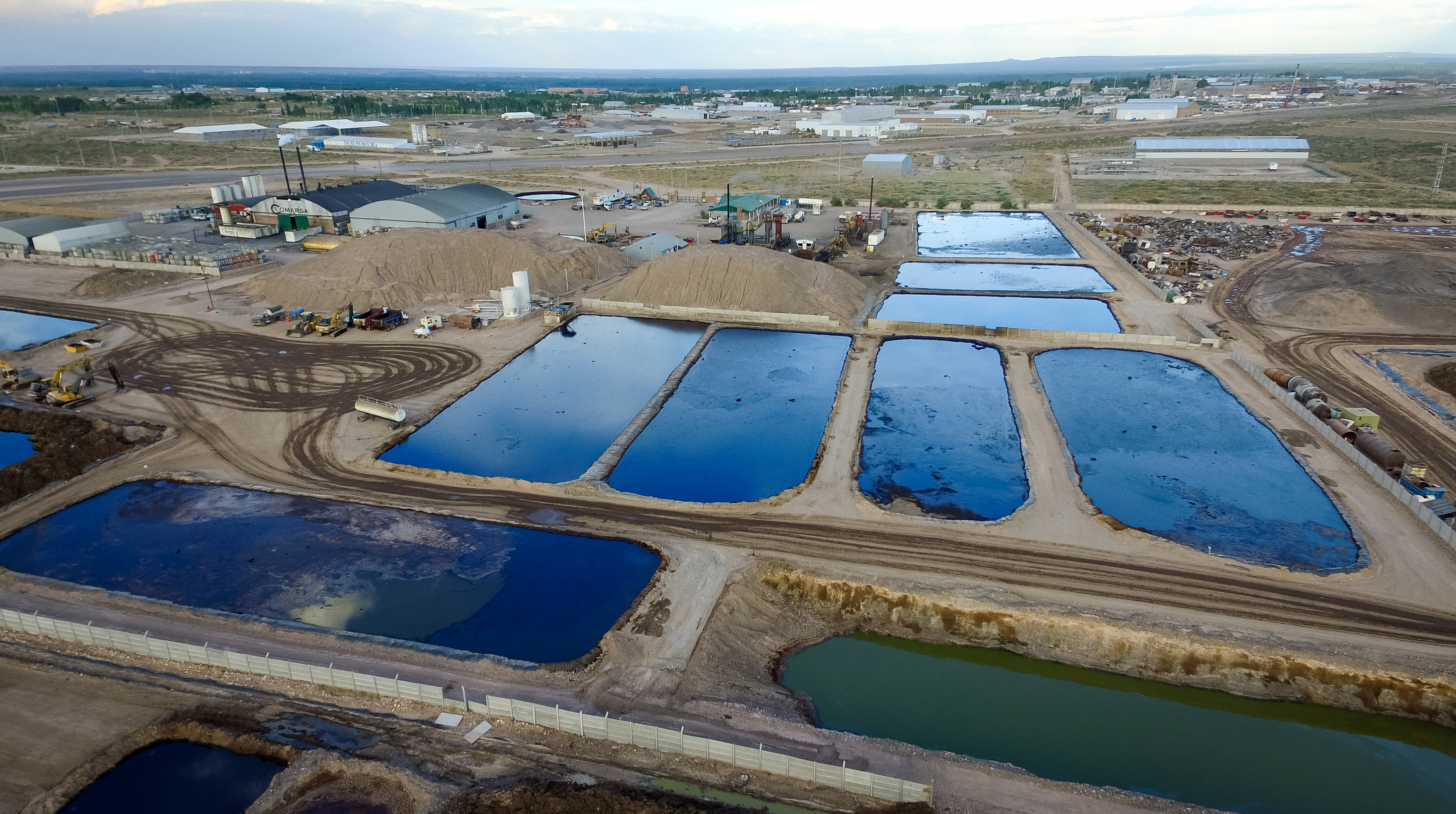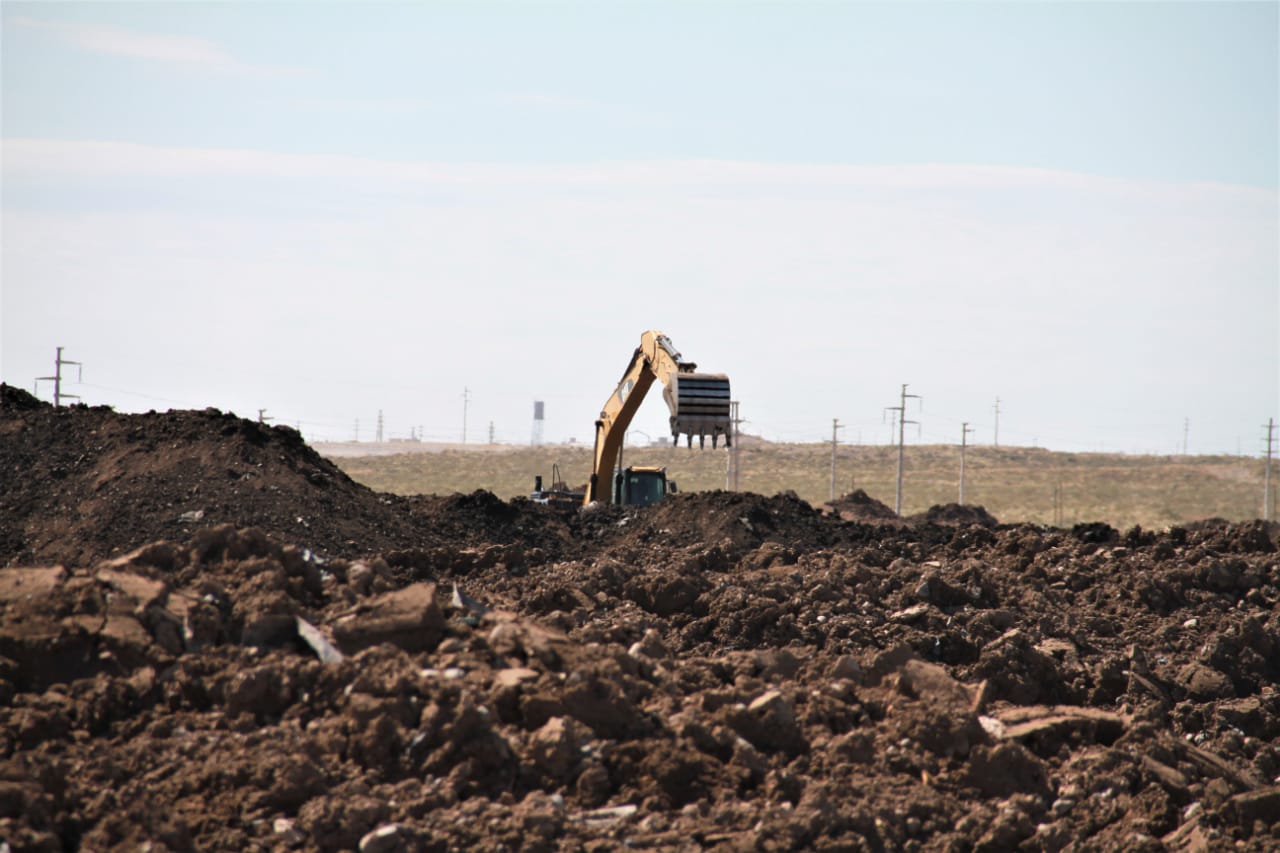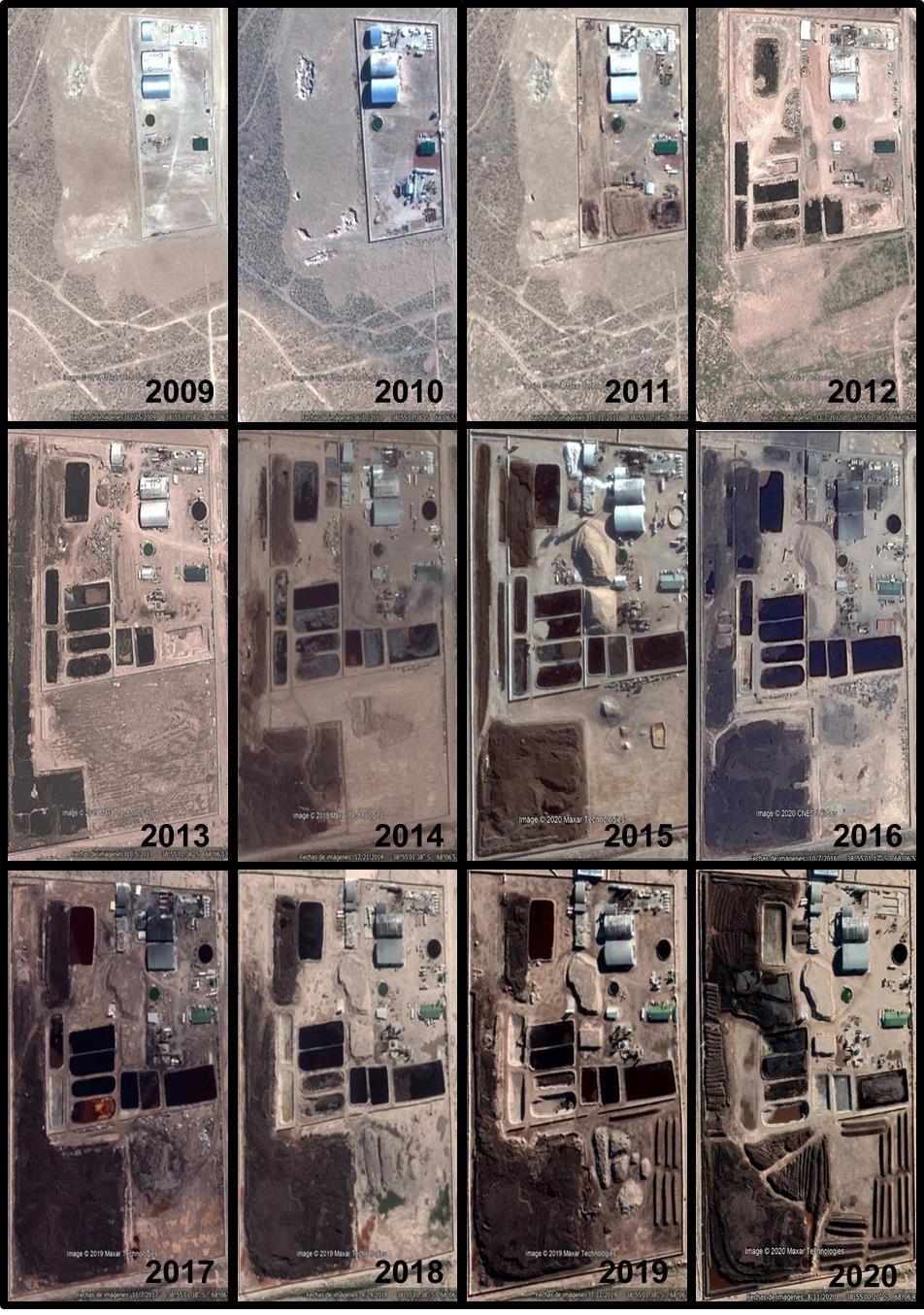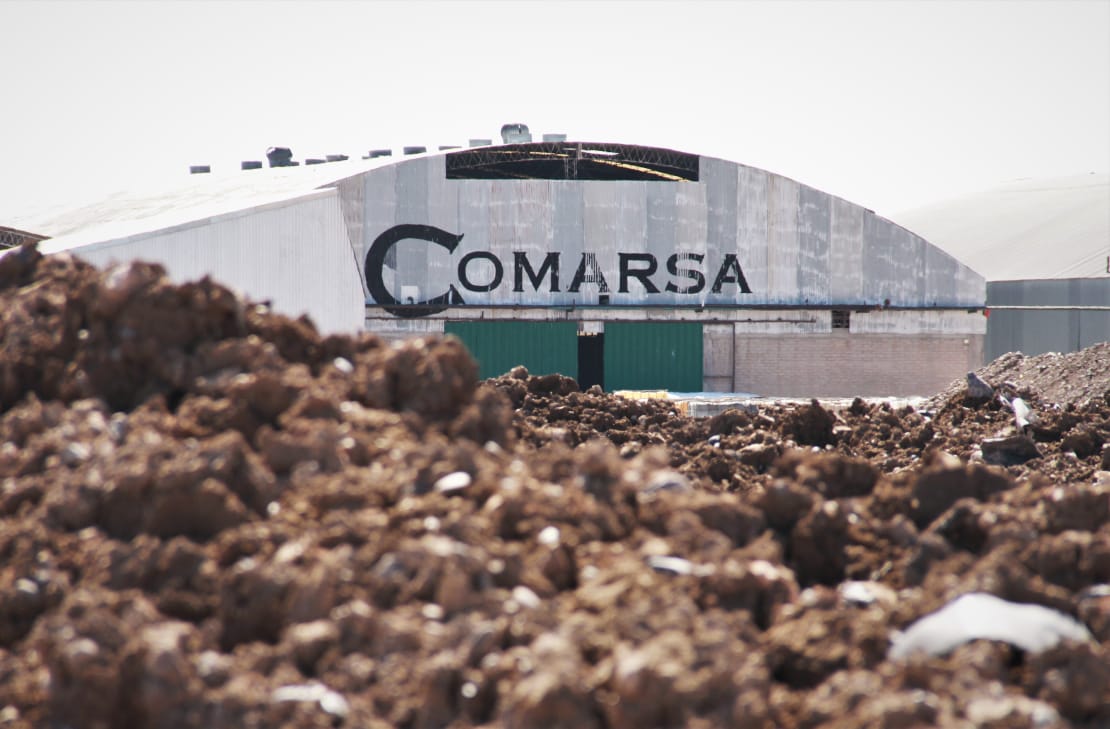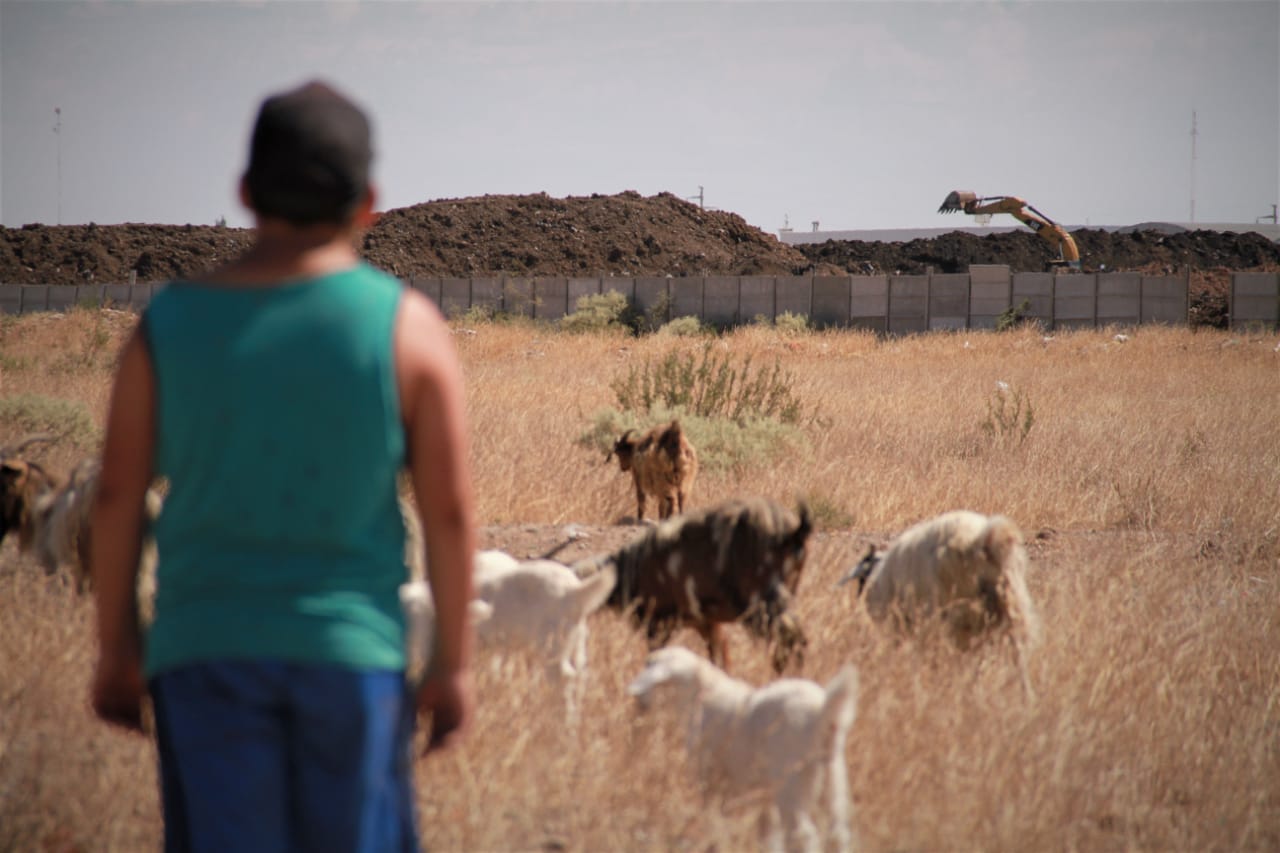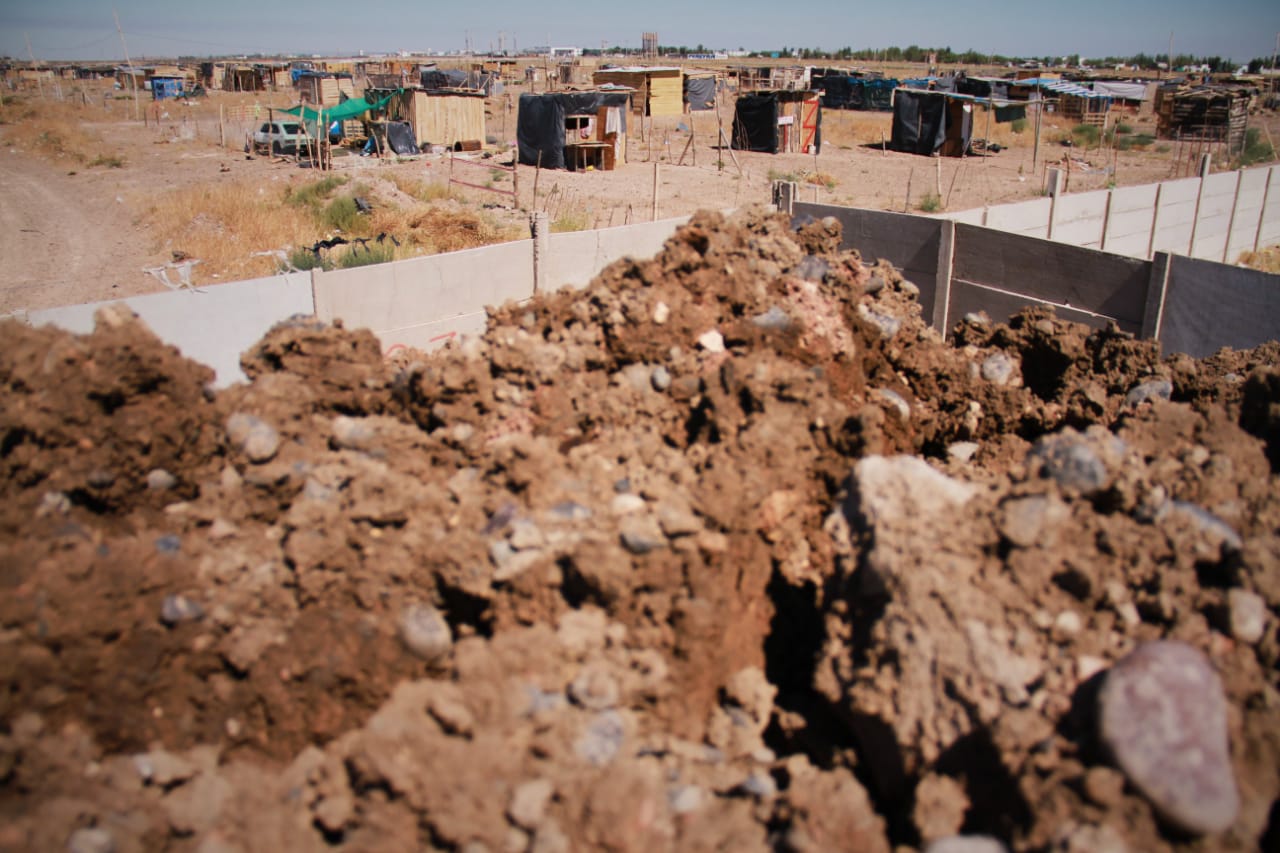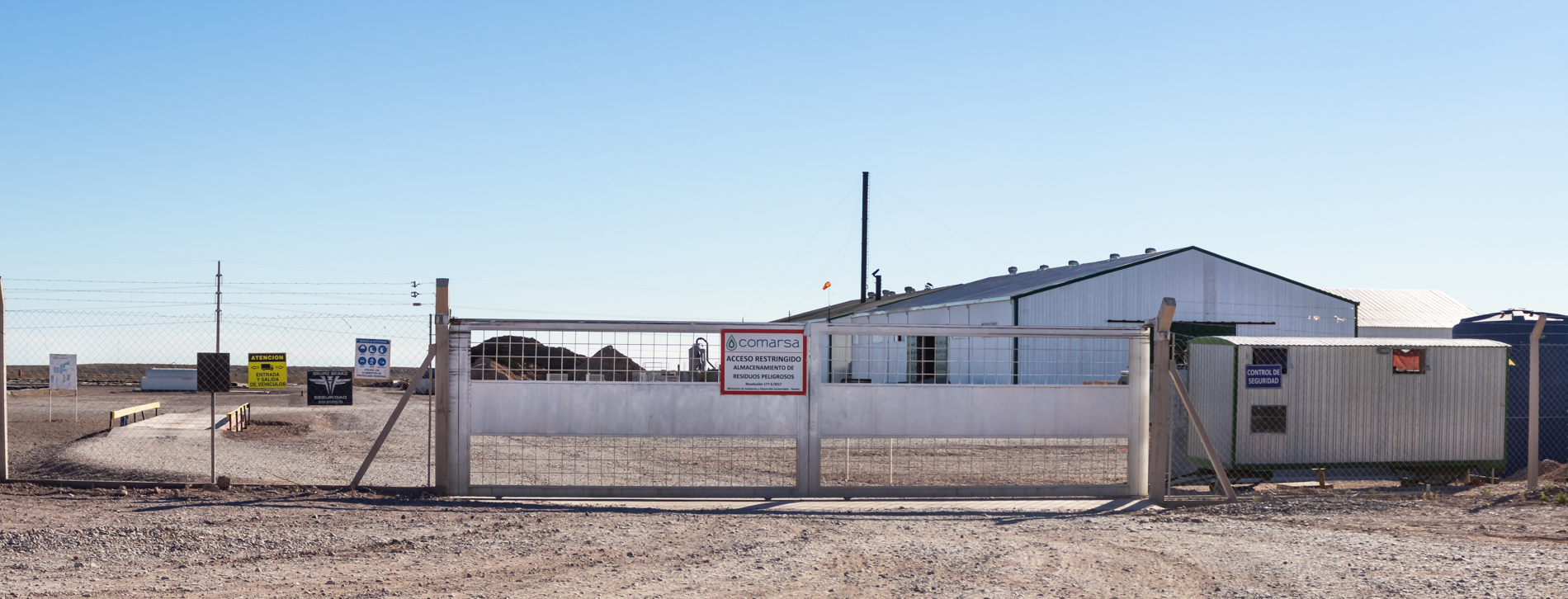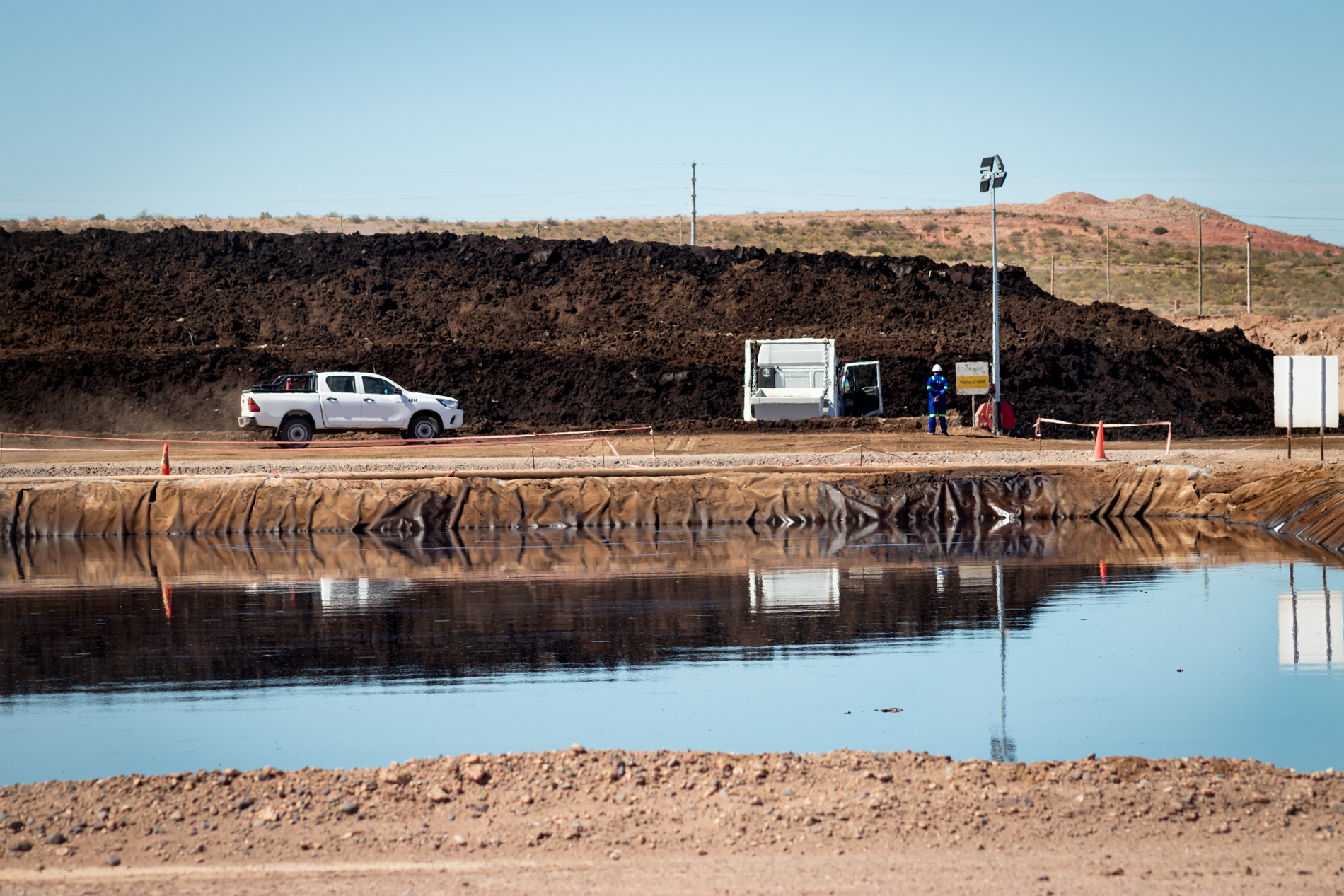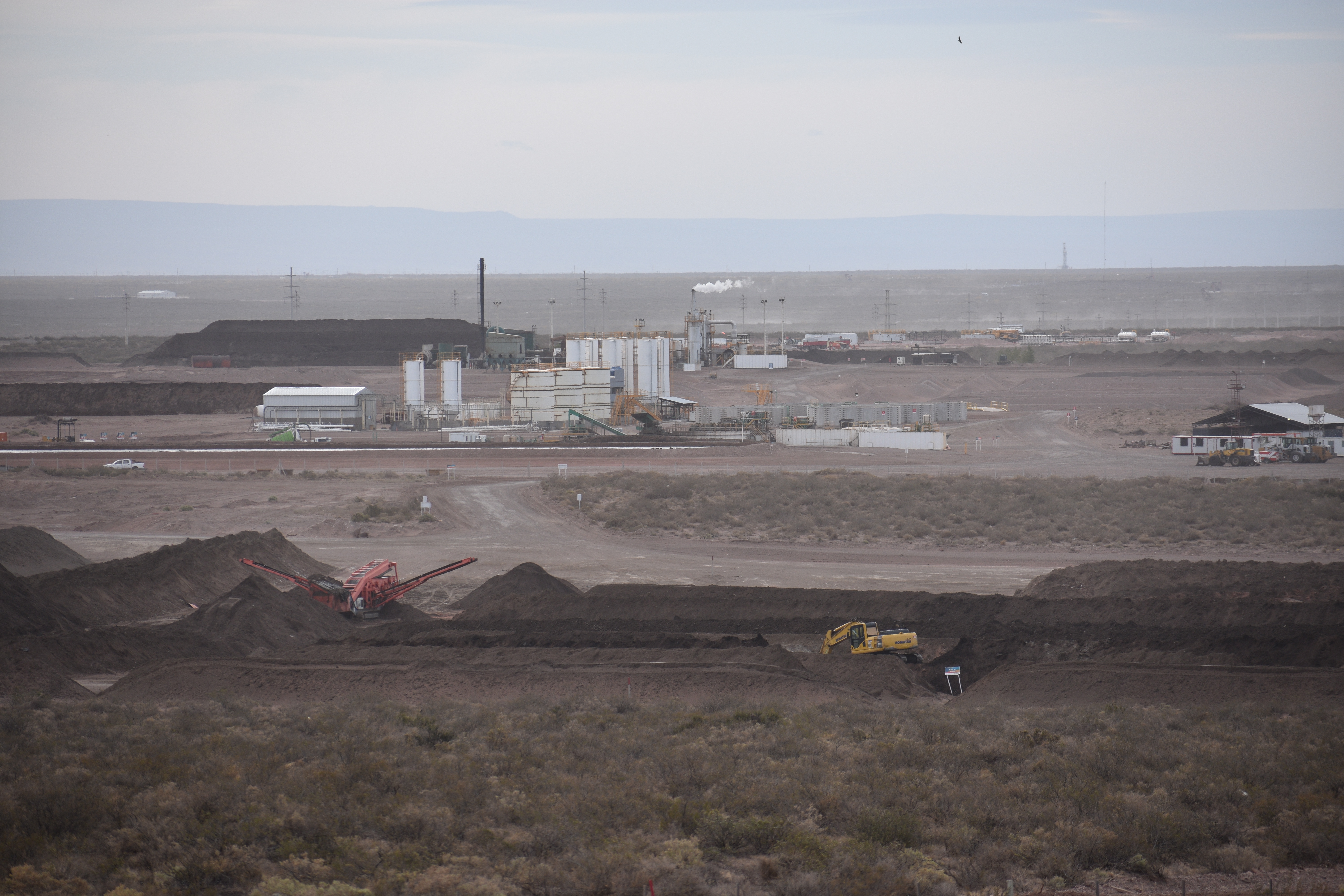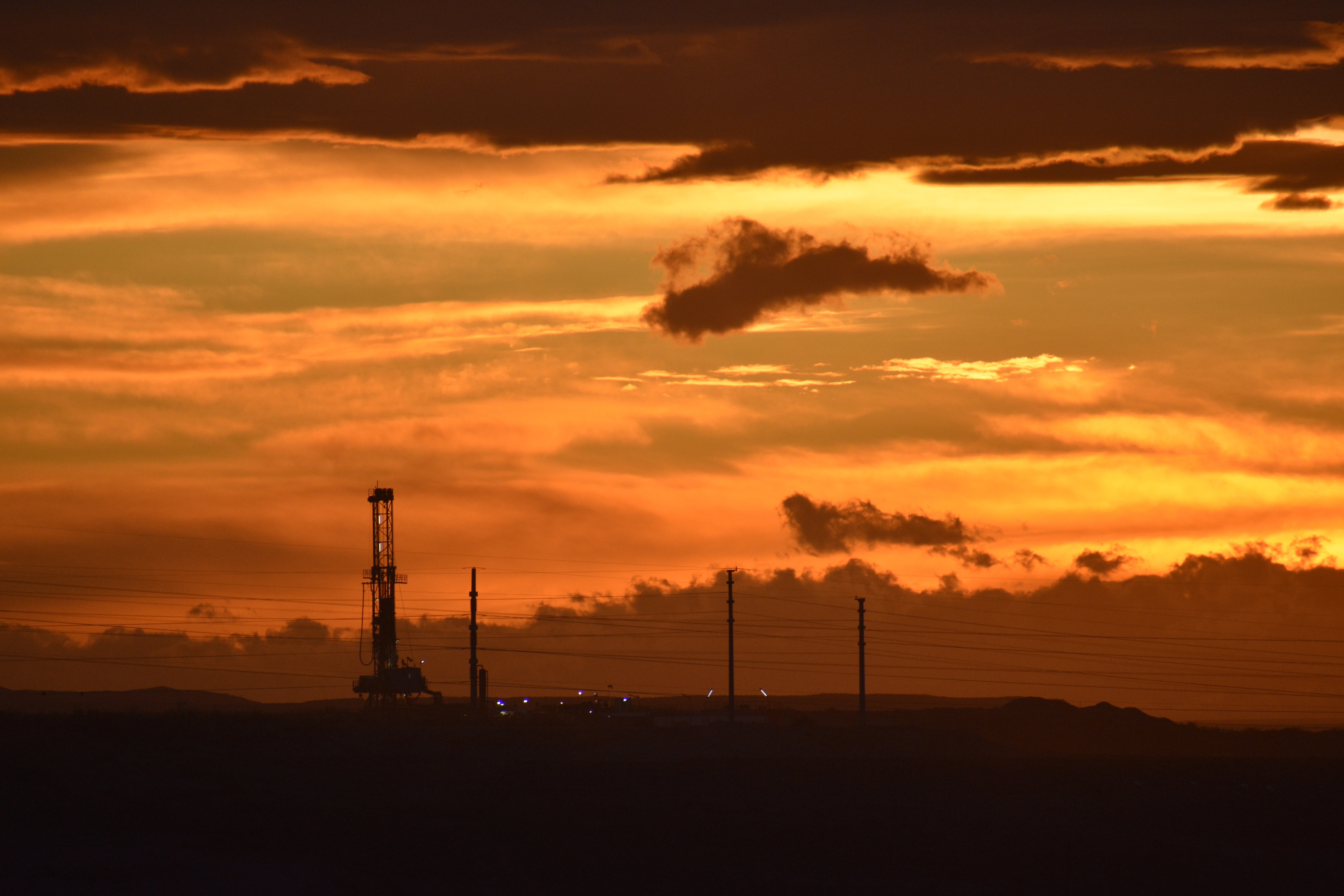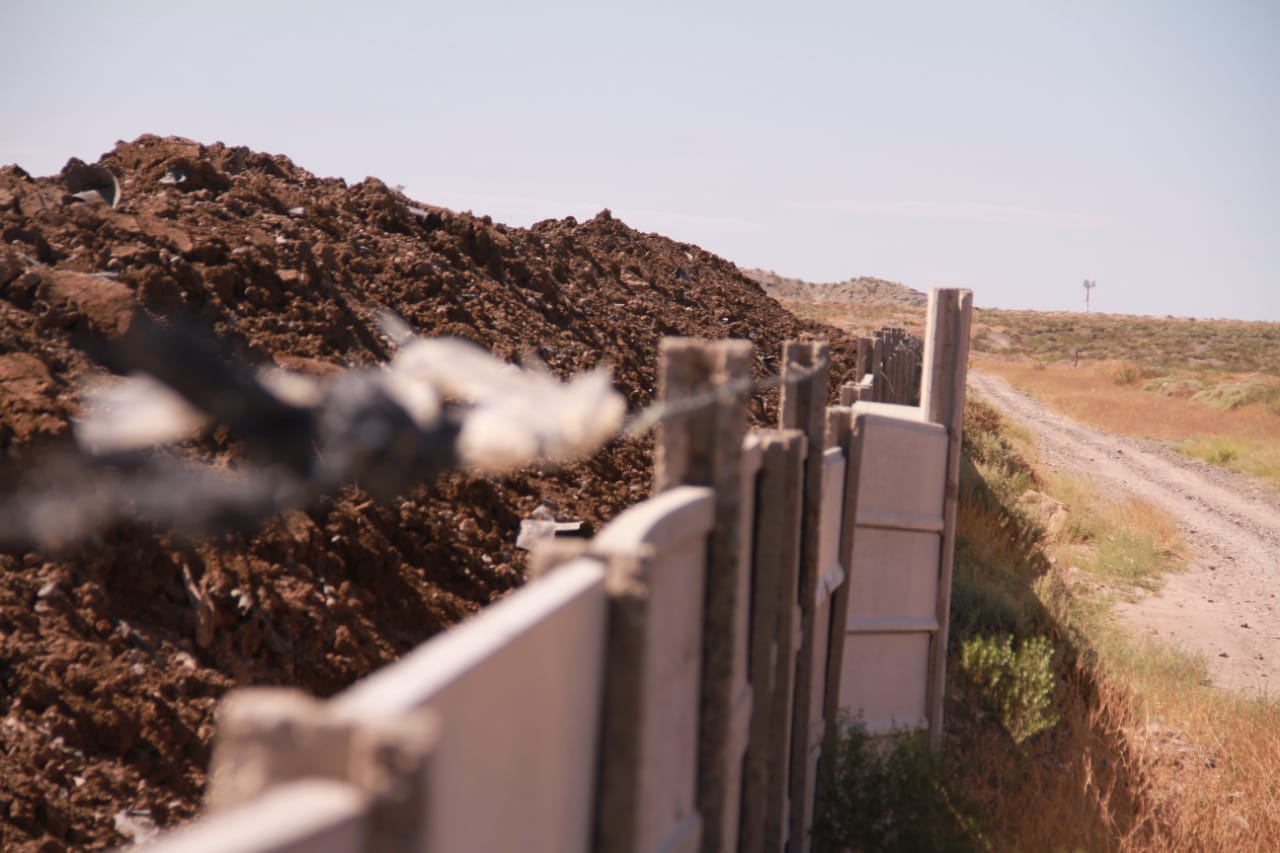On December 21, 2020, environmental crimes investigators in the western Argentine province of Neuquén carried out a raid against a company that handles fracking waste in the heart of the Vaca Muerta shale basin, a booming oil and gas field in northern Patagonia. They seized a cache of documents, and opened an investigation into the potential illegal handling of massive volumes of fracking waste.
The raid on the Argentine waste company Comarsa by the office of Environmental Crimes and Special Laws, a unit under Neuquén’s chief prosecutor, was prompted by a lengthy criminal complaint filed to the office just a few days earlier by a group of environmental lawyers. Within the complaint, the lawyers document what they describe as a decade-long illegal accumulation of toxic fracking waste at multiple sites in the city of Neuquén, the largest city in Patagonia with a population over 300,000. The sites are located within the city and also on the outskirts of Añelo, a small desert town of 8,000 about an hour and a half drive northwest of Neuquén and the unofficial drilling capital of the Vaca Muerta.
But the criminal complaint didn’t just target Comarsa, one of the leading handlers of fracking waste in the Vaca Muerta. It also pointed fingers at the municipalities of Neuquén and Añelo, the Secretariat of Territorial Development and Environment (environmental regulators for the province of Neuquén), and the region’s top oil producers, including ExxonMobil and Chevron.
“The Vaca Muerta oil dumps are the result of a series of maneuvers that are part of a collusion between companies and state authorities,” Rafael Colombo, a lawyer for the Argentine Association of Environmental Lawyers, or AAAA, said in a press release when he filed the criminal complaint in December. According to AAAA, Comarsa earns huge sums “for the treatment of waste that they never treat,” Colombo said, “then they get the State to give them public lands to end up disposing of hazardous waste illegally.”
The illegal fracking waste sites are the “dark side” of Vaca Muerta, he said.
Aerial view of Comarsa’s oil and gas waste storage and treatment facility in the city of Neuquén, Argentina. Credit: Martín Barzilai
Fracking for oil and gas produces enormous quantities of liquid and solid waste. After a well is drilled, a slurry of water, drilling fluids, and other chemicals is injected into the well at extreme pressures to fracture the rock. Much of the resulting toxic cocktail, which can contain heavy metals and naturally occurring radioactive contamination, is returned to the surface for disposal.
Drill cuttings, the pulverized rock from the drilling process, can also be radioactive.
Disposing of this waste presents problems for drillers. Sometimes they reinject it deep underground, a process that can contribute to increased seismic activity. Drillers may also store waste in tanks or lined pits, or “recycle” and repurpose it for other industrial uses, each of which carries its own set of environmental and safety hazards.
Argentina’s Vaca Muerta shale has some of the world’s largest oil and gas reserves, and “possibly the most prospective outside of North America,” according to a 2015 analysis by the U.S. Energy Information Administration. But just as the problems with disposing of fracking waste can fly beneath the radar of regulators and the public in places like Ohio and Pennsylvania, the fracking boom in the Vaca Muerta has led to oilfield waste sites that are poorly monitored, creating the possibility of health, safety, and environmental risks.
According to AAAA, drillers have used at least two sites in the Vaca Muerta to illegally dump vast quantities of waste in unlined pits, and failed to properly treat the waste. The sites are also illegally located close to residential neighborhoods.
Oil and gas drilling waste at Comarsa’s processing facility in the city of Neuquén, Argentina. Credit: Lucas Castillo, Izquierda Diario
AAAA’s criminal complaint targets two specific waste facilities owned by Comarsa, whose clients include top regional oil producers, including state-owned firm YPF, as well as Chevron, Halliburton, Total, and Tecpetrol, among others. One of the facilities identified in the lawsuit is located near Añelo, close to the Vaca Muerta’s flagship oil field. Another is located just a few hundred feet from urban neighborhoods in the city of Neuquén.
The complaint presents extensive evidence of improper waste disposal. In one instance, the complaint cited a period in 2012 when the company added seven large waste pools over the course of less than five months. Each of the seven new pools was roughly three-quarters the size of an American football field.
According to AAAA, if Comarsa were properly handling the waste, it would be impossible for the number of sites to grow this quickly. The group alleges that Comarsa dumped the waste in pits that had not been lined properly to prevent contamination of the soil. AAAA gathered satellite imagery which it submitted as evidence in the criminal complaint to back up this claim.
Satellite images of a Comarsa oil and gas waste processing facility expanding between 2009 and 2020. Credit: AAAA, Argentine Association of Environmental Lawyers
In addition, the group of environmental lawyers claims these waste storage sites also lack proper waste treatment equipment such as specialized furnaces, adding further evidence to the claim that Comarsa wasn’t interested in proper disposal.
AAAA also alleges that Comarsa’s plan for “bioremediation,” which involves letting the semi-liquid waste sit out in the sun to allow microbes to eat away at the contamination over time, was plainly unviable from the start. The semi-liquid drill cuttings were too contaminated with oil for bioremediation to work properly; they contained 15 percent hydrocarbon content, but bioremediation only supports a maximum of 5 percent hydrocarbon content, says AAAA.
Bioremediation also requires a consistently hot and dry climate. The climate of northern Patagonia is hot and arid, but only during the summer months. The clay soils found in the Vaca Muerta add further complications, as they tend to clump and cake together, slowing the oxygenation process and inhibiting the microbial activity needed to break down the waste into less toxic forms.
Taken together, bioremediation could take nearly 25 years to work its magic on Comarsa’s waste stockpile, not the five years that the company promised, according to the criminal complaint.
It is inconceivable that either Comarsa or government regulators would be unaware of these problems, AAAA says.
The organization’s filing “is a very solid complaint because it offers official documentation that shows lack of control over the management of toxic waste,” Fernando Cabrera, a journalist and coordinator with Observatorio Petrolero Sur (OPSur), an Argentine NGO, told DeSmog. The mountain of evidence presented “is not very refutable,” he said, and is indicative of a reckless culture surrounding the development of Vaca Muerta. “We could assume that other areas of the Vaca Muerta are also managed with that degree of carelessness.”
Illegal Storage of Fracking Waste, With Help From the State
AAAA’s criminal complaint also alleges that the blame extends far beyond one careless waste handler. Municipal and provincial authorities of Neuquén not only failed to enforce basic laws concerning proper storage of hazardous waste, AAAA charges, but also apparently facilitated an unauthorized expansion of Comarsa’s waste storage sites into pits on public land in 2012, again without proper safeguards.
A Comarsa oil and gas waste storage and treatment facility in Argentina’s Neuquén province in the city of Neuquén. Credit: Lucas Castillo, Izquierda Diario
After Comarsa had built new waste pools on public land that they didn’t have rights to, the city of Neuquén sold Comarsa that land in December 2013 at below-market prices, according to AAAA.
In another instance, a 2015 provincial decree regulating fracking waste required that hazardous waste storage and disposal sites be at least five miles from urbanized areas. These rules should have forced the closure of the Neuquén oilfield waste site, which is located less than four miles from the provincial legislature building, in the heart of the city, and about 600 yards from urban neighborhoods.
Despite the provincial decree in 2015, the volume of drilling waste at the Comarsa site continued to expand, from 8.6 million cubic feet in 2016 to 11.6 million cubic feet as of January 2019, according to evidence collected by AAAA. In order to increase waste volumes by that much, an average of 150 to 185 trucks fully-laden with hazardous waste would have needed to enter the site each month.
“In other words, after more than six years, the waste is still in the vicinity of the neighborhoods of the main city of Patagonia,” Cabrera said.
The threat of spills from fracking waste sites remains omnipresent. In 2014, for example, less than four miles away from Comarsa’s site in Neuquén, a spill occurred from a waste pool owned by another company called Indarsa. Oily sludge oozed into the street. The waste pool was not built to legal specifications, and provincial authorities were “very annoyed” that they only found out about the accident due to media reports. Local press published a video of workers mopping up the sludge from the street.
Local news video of a 2014 spill from Indarsa’s oil waste pool, less than four miles away from Comarsa’s site in Neuquén, Argentina.
Nearby residents say the impacts are impossible to ignore. “Living here is totally suffocating,” said Marisa, a mother of four, as relayed to DeSmog by Esteban Martine, a journalist with Izquierda Diario, a digital news site in Argentina.
Marisa lives with her husband and their 9-year-old in a makeshift house a mere 25 yards from Comarsa’s property. “Every day we smell and taste of gasoline. It sticks to your nose, it dries your throat. You feel the air very dense, very heavy.”
Marisa is one of dozens of people who live in houses made of plywood and plastic tarps, which lack running water, electricity, or gas for heat and cooking. She says she sees workers at Comarsa creating mounds of waste, and every day they stir it up and move it around. When living in such proximity, “Clothes have that smell on you and it’s hard to get it off,” she said.
A man watches as livestock graze near heavy machinery working at an oil and gas waste processing facility in Neuquén, Argentina. Credit: Lucas Castillo, Izquierda Diario
The smell is “too much,” Mica, another nearby resident, told Martine. She is pregnant and has lived with her husband close to the Comarsa waste site in Neuquén for about nine months.
The desert land where they live is “not really suitable for living” and the houses are “very precarious,” Esteban Martine told DeSmog.
Marisa and Mica both say that they don’t like living close to Comarsa, but have no other options. Deep poverty on the outskirts of the city, combined with Neuquén’s housing shortage, has driven the growth of informal settlements with dilapidated housing such as those where Marisa and Mica live, so even as Comarsa’s footprint has grown over time, these informal settlements have also moved closer to hazardous industrial sites.
While the shacks are relatively sparse right over the fenceline from Comarsa, much denser urban neighborhoods lie a few hundred yards away.
Informal settlements have sprung up near Comarsa’s oil and gas waste dump in the city of Neuquén. Credit: Lucas Castillo, Izquierda Diario
Anecdotally, residents in close proximity to the hazardous waste site report health problems. “Respiratory problems are the most directly related” to the waste site, “which is also aggravated by the fact that many of the populations that live near the treatment plants or the oil fields do not have heating and use the burning of firewood as their main source of heat,” said Lorena Riffo, a researcher and teacher in the Faculty of Law and Social Sciences at the National University of Comahue in Neuquén.
A lack of independent studies on the potential health effects means the full impact is unknown. “Health studies would be necessary, but there is no money or operational capacity to carry them out,” Riffo said.
The government uses the lack of health data as an excuse for not taking punitive action against polluters, she says. “It is precisely under this excuse that the State itself, which could be allocating resources to carry out [health studies], takes refuge to say that there is not enough evidence of the consequences for nature or for the population, to stop the activity.”
Instead of forcing the facility’s closure, in 2016 the province approved an acquisition of public lands by Comarsa for a second waste site near Añelo, a northern Patagonian desert town that has grown rapidly over the past decade due to its close proximity to actual oil and gas drilling sites. Earthen pits at this new site began filling up with fracking slurry at a rapid clip beginning in 2017, according to AAAA, as well as with drill cuttings and other partially-liquefied drilling muds.
Outside the gates of Comarsa’s Añelo oil and gas waste processing facility in Neuquén province, Argentina. Credit: Martín Álvarez Mullally, Observatorio Petrolero Sur
While it took a decade to accumulate over 10.6 million cubic feet of fracking waste at the Comarsa site in Neuquén, the company collected over 3.5 million cubic feet at its Añelo site in just three years, between December 2017 and December 2020.
The city and provincial governments’ culpability goes beyond simply looking the other way, AAAA alleges, because Neuquén granted Comarsa public land allotments on multiple occasions to facilitate the expansion of its oilfield waste sites. “Public authorities on the contrary have actively favored the companies by giving them public lands that will end up accounting for an environmental liability that is probably irreversible,” Colombo, the lead lawyer with AAAA, told DeSmog.
The complaint calls on the provincial public prosecutor to order the immediate closure of the waste sites, and for an investigation into the Undersecretariat of the Environment, the provincial environmental regulators, for failing to enforce environmental laws and allowing Comarsa’s waste site in Neuquén to expand even after the 2015 provincial decrees made the site’s operation illegal.
In addition to Comarsa and Neuquén authorities, the legal complaint names a third class of culprits: the largest oil producers in the Vaca Muerta, including YPF, ExxonMobil, Chevron, Total, Royal Dutch Shell, and a handful of others. While Comarsa owns the waste dumps, the waste originated from the drilling operations of these oil companies. “These companies are the main ones responsible because they produce the volumes of waste that companies like Comarsa should treat later,” Colombo said.
Even though the oilfield waste is transferred to the dumps, the drillers are still legally on the hook under both federal and provincial law. In the criminal complaint, the AAAA cited the “cradle to grave” responsibility that oil companies have to adhere to: They can be held liable for the improper disposal of waste even if handed off to third parties.
Colombo decried the “illicit” business dealings between the Vaca Muerta oil industry and the Argentine state. “We think Vaca Muerta is a blind commitment to a large state polluter and predatory energy extractive industry,” he said.
Comarsa declined to comment, and the Neuquén Public Prosecutor did not respond to requests for comment. DeSmog contacted the eight oil producers named in the criminal complaint and none responded.
The Treater oil and gas waste storage and treatment facility near the Vaca Muerta oil boom town of Añelo, Argentina. Credit: Martín Álvarez Mullally, Observatorio Petrolero Sur
An Attempt at Justice?
A second investigation into a separate company’s waste treatment site is also moving forward. In 2018, Greenpeace Argentina, working with the Mapuche Confederation of Neuquén — a coalition of Indigenous Mapuche communities — and AAAA, filed a criminal complaint against a fracking waste facility owned by a company called Treater, which stored waste in trenches and earthen pools at an expansive field in the Patagonian desert near Añelo.
The particulars of the Treater case are similar to Comarsa’s situation, alleging improper storage and disposal of fracking waste at a dump just a couple miles from the town, with the complicity of oil producers and the province. In May 2020, a Neuquén prosecutor closed the investigation over lack of evidence, but a provincial judge reactivated it in November.
The Treater oil and gas waste dump in Añelo, Argentina, in 2019. Credit: Nick Cunningham
It’s the first time there are strong legal cases against multiple waste facilities that are “a central link” in the previously unchecked development of Vaca Muerta, OPSur’s Cabrera told DeSmog. “It is in the waste treatment plants where the environmental impact of the extraction is most clearly exposed to the population,” Cabrera said.
But the saga is more than just a story about illegal waste disposal. Over the past decade, Argentine politicians from across the political spectrum have positioned the rapid growth of Vaca Muerta as a national priority. Amid a multi-year economic crisis that predates the pandemic, multiple presidents representing disparate ideologies have championed Vaca Muerta’s development, heavily subsidizing its growth, and describing shale drilling as a cornerstone of economic recovery.
On March 1, in an address to the National Congress, President Alberto Fernandez laid out his agenda for the further expansion of Vaca Muerta, in order to make Argentina “a regional and global energy exporter,” continuing a longstanding policy across multiple presidential administrations. But Fernandez also offered something of a new twist, arguing that exporting natural gas from Vaca Muerta could help “minimize the effects of climate change,” repeating an industry talking point that natural gas offers greenhouse gas benefits over other forms of fossil fuels. His government is set to continue subsidizing the same companies that dispose of their waste at sites run by firms like Comarsa.
Argentina’s politicians have lined up in support of drilling in the Vaca Muerta shale region. Credit: Nick Cunningham
Even with strong government support, Vaca Muerta’s expansion has proceeded in fits and starts due to a variety of economic, infrastructure, and political challenges. A volatile and unstable currency, intense economic inflation, capital controls, and other macroeconomic headwinds have deterred investment. On-again, off-again subsidies have meant the financial spigot from the state for drillers, while generous, is unreliable. The lack of infrastructure — roads, compressor stations, and most importantly, long-distance pipelines — constrain the ability of oil and gas producers to move their product.
But perhaps the most important factor has been the global oil market’s volatility, going through multiple downturns in the past decade. Vaca Muerta is not the most competitive source of new oil and gas, and when multinational companies have been forced to cut costs or write down assets, their Argentine investments sometimes end up on the chopping block.
The pressure to constantly lower operating costs almost inevitably results in the industry cutting corners, says Cabrera. “Greater environmental care implies higher costs and companies are not willing to face them,” Cabrera said. “And the states ask them to exploit anyway.”
The Environmental Crimes and Special Laws office is investigating the fracking waste sites in Neuquén and Añelo. The criminal complaint filed by AAAA calls for the immediate closure of the waste dumps and a broader investigation into potential illegal activity committed by environmental regulators.
Despite the extensive documentation of crimes and multiple investigations now underway, there is no guarantee that business as usual will change for Vaca Muerta. Political pressure from provincial authorities and their cozy relationship with the oil industry — a powerful political and economic force in the region — present huge obstacles for those pushing for the industry to clean up its act.
Oil and gas waste piles at a Comarsa processing facility in Neuquén, Argentina. Credit: Lucas Castillo, Izquierda Diario
“Only pressure from the population and organizations can move the cause forward,” Cabrera said. “Without that pressure, the two [investigations] will surely be shelved.”
He added that there are signs that the Argentine public is starting to grow a bit more skeptical of Vaca Muerta, as the promises of prosperity have failed to materialize, and the costs — earthquakes, oil spills, and accidents — are increasingly evident.
Vaca Muerta still faces a litany of challenges, including chronic macroeconomic instability, high costs, and inadequate infrastructure, but production recently rebounded after suffering a steep decline from the pandemic. The Argentine government still sees drilling as a key to economic salvation, and remains steadfastly in favor of expanding the pace of drilling.
Rhetoric about the fracking “miracle” or “revolution” is a modern-day equivalent of the myth of El Dorado, Rafael Colombo told DeSmog, referring to the 16th century myth that characterized the insatiable drive by the Spanish to conquer and pillage much of South America and extract its natural resources. “The companies will leave our country without cleaning up or repairing the profound damage caused to the lands,” he said, “much less compensating the neighborhoods and communities affected.”
Main image: A worker walks by a waste pool at Treater’s oil and gas waste dump in the Patagonian desert town of Añelo, Argentina, near drilling in the Vaca Muerta shale basin. Credit: Martín Álvarez Mullally, Observatorio Petrolero Sur
Subscribe to our newsletter
Stay up to date with DeSmog news and alerts



